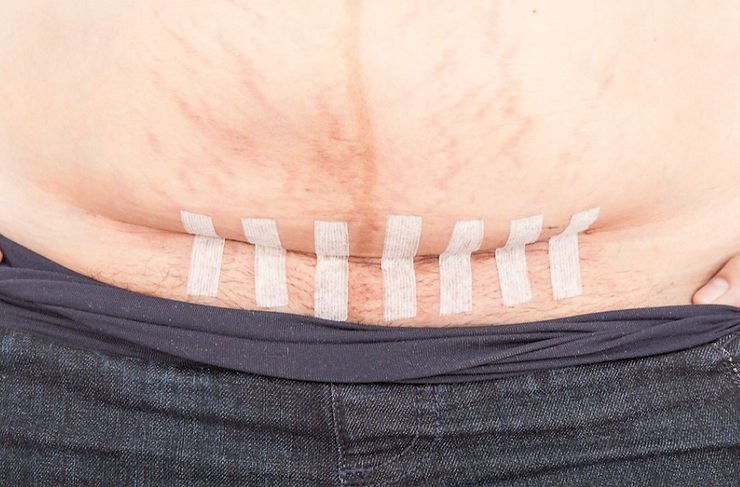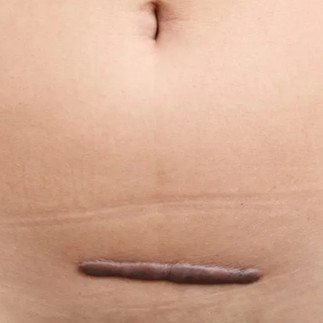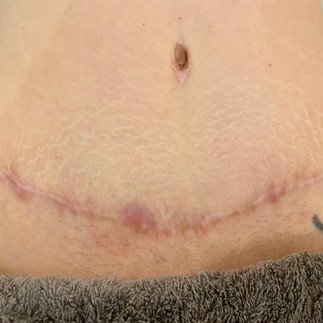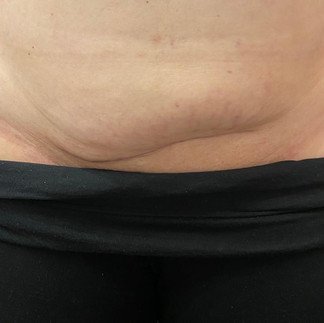What should I do about my C-section scar?
Author: Amy Poole. Updated: Mar 18, 2023
Find out the best line of treatment for your scar, from a scar specialist. This article will take a look at what is involved in a c-section, the common symptoms that you might experience, and what can be done to help.
Should I have Scarwork™ therapy, and why is it beneficial?
Caesarean birth rates are on the rise globally, accounting for 21% of all births. The World Health Organisation predicts that by 2030, this will have risen to 29%. In the UK, The Office for National Statistics reported that in 2019 the percentage of caesarean birthswas 34%, with 15% being elective and 19% being emergency caesareans.
When giving birth abdominally, frequently mothers are underprepared for what their recovery might involve, ongoing symptoms they may have as a result of the surgery, and what help is available to them to promote recovery in the short and long term.
What happens during a Caesarean birth?
During a C-section birth, the surgeon cuts through seven layers of tissue: skin; fat; rectus sheath (covering of your abdominal muscles); rectus muscles (abdominals) are separated; parietal peritoneum (first layer surrounding organs); loose peritoneum; uterus.
During any surgery, a structure called fascia is affected. Fascia is a web-like structure of connective tissue that envelops every muscle, bone, nerve and organ, interconnecting your entire body. This irregular pattern of collagen fibres spread across several layers are constantly communicating, and if it becomes disrupted in one area of the body, this can have a knock on effect elsewhere. This tends to affect body posture and movement.
What happens to these layers afterwards?
After surgery, your body undergoes a period of healing, and lays down new collagen. Over time this changes, matures and remains this way as your new skin and tissue. This period lasts for approximately two years. We can influence this healing to make sure as the new collagen fibres lay down, they do so in a more structured and aligned way.
This helps to improve and maintain mobility in the local area and its fascial connections throughout the rest of the body. Encouraging mobility through these layers can prevent adhesions from forming. Adhesions are areas where the layers of tissue get ‘stuck down’ and can cause pain, discomfort, movement restrictions, and can adhere layers of tissue to each other and to surrounding structures.
What are the main symptoms I might experience associated with my scar?
Locally, common symptoms can include:
Numbness
Altered sensation
Itching
Pulling
Raised, bumpy, thickened scarring
Soreness or hypersensitivity
More widespread symptoms can include:
Hip pain
Back pain
Digestive issues
Pelvic floor dysfunction
Menstrual discomfort
Tummy ‘overhang’
How can I manage these symptoms or help to prevent them?
There are several types of manual therapy that can be used to improve the mobility of your scar and surrounding areas, and improve symptomatic tissue.
ScarWork™ uses a range of very specific techniques that aim to improve how your layers of fascia ‘slide and glide’ over each other, and are very effective at stimulating superficial nerve endings to either dampen down a hypersensitive area, or stimulate areas of numbness.
What sets these techniques apart is that they can be used very superficially, which makes them really useful if your scar or tummy is hypersensitive. Because they aim to restore fascial integrity, they also do not have to be used directly over your scar sight. As previously discussed, our fascia is interconnected and working more globally can still have a huge positive impact, so if you are not yet ready to have someone make direct contact with your scar, this can be a great option.
Scar massage often uses slightly deeper techniques to influence deeper layers of the scar site and surrounding tissue. It can integrate work onto the abdomen, lower back and hips and diaphragm as these areas commonly become tight and dysfunctional. Releasing these areas can help to restore normal movement patterns through the whole core canister and body.
Finally, methods such as fascial cupping and specialist medical devices like Lymphatouch can help to gently physically lift adhered tissue using negative pressure, or a vacuum type effect. These can also be used very gently, but very specifically making treatments individualised and is a great way of tracking progress. It’s important to note that these techniques should be used by a professional who is appropriately trained.
There are different types of scarring, and not all techniques are suitable on all types of scar. The best outcomes are usually achieved by using a mix of these techniques, according to individual needs and treatment goals.
What else can I do to help my scar?
Mobilising your scar in ways other than massage. You can do this via gentle stretching, mobility exercises, and breathwork which can help to apply a gentle stretch from the inside out.
Keep the scar hydrated, particularly within the first two years when your scar is still immature. You can use specialised scar products which nourish the scar, but also form a barrier to reduce trans-epidermal water loss (water evaporation through the skin).
Good hydration and nutrition is key, particularly in early healing - connecting with someone who specialises in this area would be a great asset to your recovery.
Pelvic health physiotherapy is often a key component in c-section rehabilitation. Your pelvic floor function is inextricably linked to the way that you move, and this can become disrupted during pregnancy and delivery, regardless of the way you birth your baby.
Can my scar be ‘too old’ for my symptoms to improve?
It is never too late to work on your scar, or for your symptoms to improve. Whilst you will always have a scar, many things can be done to help integrate your affected tissue into the surrounding healthy tissue. Many symptoms from surgery may exist beyond your scar site as a result of fascial pull and compensations. This means that there's always something that can be done to improve the quality of movement and reduce chance of discomfort.
Author: Amy Poole, Scar specialist at Alma Physiotherapy. Read more about Amy here.
References
Betran AP, Ye J, Moller AB, et al. Trends and projections of caesarean section rates: global and regional estimates. BMJ Global Health, 2021.
https://digital.nhs.uk/data-and-information/publications/statistical/maternity-services-monthly-statistics/january-2022-experimental-statistics
https://www.who.int/news/item/16-06-2021-caesarean-section-rates-continue-to-rise-amid-growing-inequalities-in-access
Van der Wal J. The architecture of the connective tissue in the musculoskeletal system-an often overlooked functional parameter as to proprioception in the locomotor apparatus. Int J Ther Massage Bodywork. 2009;2(4):9–2.
Chaudhry H, Schleip R, Ji Z, et al. Three-dimensional mathematical model for deformation of human fasciae in manual therapy. J Am Osteopath Assoc. 2008;108(8):3793–3790.
Bordoni B, Zanier E. Skin, fascias, and scars: symptoms and systemic connections. Journal of Multidisciplinary Healthcare. 2014:(9) 11–24.
Lande NX, Li D, Stahle M. Cellular and Molecular Life Sciences. Transition from inflammation to proliferation: a critical step during wound healing. 2016; 73:3861–3885.
Deflorin C, Hohenauer E, Stoop R, et al. Physical Management of Scar Tissue: A Systematic Review and Meta-Analysis. Journal of alternative and complementary medicine. 2020;26 (10).










